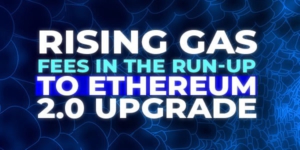
Ethereum gas fees have been on the rise since the beginning of the year. In the latest developments, miners on the world’s second-largest blockchain protocol were voting to increase the gas limit from 10 to 12.5 million Gwei. This increase of 25 percent in miner fees contributes to the more than 75 percent rise year-to-date.
Glassnode data show that the gas fees have risen from $130.66 on 1 January to $229.14 on June 20.

Ethereum Gas fees up more than 75 percent year-to-date | Credit / Glassnode
Users pay Gas fees to have their transactions added to a block. Ethereum’s block size is dependent on the amount of gas used per block. This is one of the differences between Bitcoin and Ethereum as the former has a fixed block size. In essence, Ethereum’s block size is determined by the gas fees announced by miners, which they do so by publishing the gas limit used in the most recent block.
The amount of gas depends on the computational complexity of the transaction in question. Executing a smart contract requires more gas than executing a simple transaction. As a rule of thumb, the simpler the transaction, the lower the Gas fees.
The Gas fees are a measure of economic activity on the blockchain protocol. The rising fees point to an increase in usage of the Ethereum network. Delphi Digital explained in a report that the high usage is a “mix of USDT transactions and DeFi application with some scam/Ponzi schemes sprinkled in.” This increase in usage results in higher transaction fees which generate high income for miners.
Ethereum 2.0 and Proof-of-Stake
Ether is the native currency on the Ethereum blockchain. The miners are paid in Ether for executing complete transactions on the network. The majority of Proof-of-Work (PoW) blockchains have an incentive structure that rewards miners for validating transactions and keeping the network secure. The more the blocks are added to a chain, the more secure it is as more network hashrate is required to perform a 51% majority attack. In the case of Ethereum, each transaction requires some amount of Gas which is then converted to Ether.
The Ethereum community has a mixed reaction to the increasing gas fees as the network gears up for Etheruem 2.0 upgrade scheduled for July. Ethereum 2.0, also known as Serenity, presents a fundamental shift in Ethereum’s architecture and economic model. The update, which will take place in several phases, will see Ethereum move from a Proof-of-Work consensus mechanism to Proof-of-Stake (PoS).
PoW is used by several popular blockchains such as Bitcoin and Litecoin. It requires miners to use huge amounts of computational energy and electricity to solve puzzles in a rat race to mine the next block. Despite being secure, PoW blockchains suffer from scalability issues, and this is why Ethereum is moving to PoS. The Ethereum blockchain can address the scalability issue by implementing Sharding when PoS goes live. Miners on the network will be replaced by validators who stake their Ether to maintain the network and create new blocks.
Increasing Gas Fees and Game Theory
The rising Gas fees have divided the Ethereum community. Ethereum lead Péter Szilágyi argued that Ethereum miners do not care “about the long term health of the network nor about DoS attacks.” Others argue that increasing miner fees can be explained in terms of game theory. In any given blockchain, miners look out for themselves. In this case, miners are trying to maximize their profits before they become obsolete when the Serenity upgrade is implemented.
Blockchain firm Bitfly pointed out that the increase of the gas limit from 10 to 12.5 million could theoretically see the Ethereum network increase its throughput from 35 to 44. This could be a milestone for the Ethereum community, but at what cost?
The rising gas fees deter Ethereum based projects from engaging in small transactions as this would cost a small fortune. In mid-June, an exchange paid $5.2 million in transaction fees on the Ethereum network. But it turned out to be a scandal in which the exchange was paying a ransom to hackers via transaction fees.
Ethereum’s future
The Serenity upgrade is one of the most highly anticipated updates on the Ethereum network. The blockchain protocol will also address the decentralization challenge by allowing more individual validators to participate and receive a return on maintaining the network. The current PoW mechanism favors entities with large capital to set up profitable mining operations. The PoS will likely level the playing field, or at least tilt the imbalance in validating the truth of the network.
